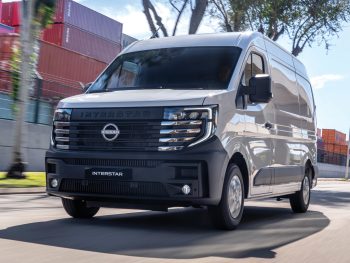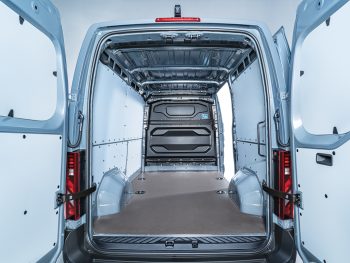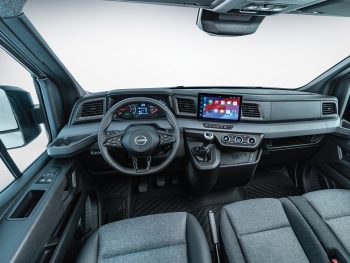Will Nissan’s latest large van impress as much as Renault’s Master? John Kendall finds out…
WHAT IS IT? Large van HOW MUCH? £32,780 / £39,145 (EV)
GROSS PAYLOAD? 1,134kg-1,847kg ECONOMY? 37.8mpg (WLTP)
RANGE? 124 miles / 285 miles DRIVE? 2.0 diesel / Single electric motor
 Nissan’s new Interstar range more or less replicates the Renault Master range, which is no surprise as the two vans are built on the same platform. Interstar is due to arrive in UK showrooms from January, with the battery electric Interstar-e following soon afterwards. We’ve had an opportunity to drive left-hand-drive versions of the van around Barcelona where it is built.
Nissan’s new Interstar range more or less replicates the Renault Master range, which is no surprise as the two vans are built on the same platform. Interstar is due to arrive in UK showrooms from January, with the battery electric Interstar-e following soon afterwards. We’ve had an opportunity to drive left-hand-drive versions of the van around Barcelona where it is built.
Interstar-e will give Nissan its first large electric van in the UK when it arrives and it will be available with a lighter and inevitably cheaper 40kWh battery for local use or an 87kWh battery for longer distance use. Nissan claims up to 285 miles of range from the larger battery, or 124 miles from the 40kWh battery. Battery choice also affects gross weight, with the 40kWh battery available with 3,500kg GVW or 3,800kg GVW and the long-range battery available with either 3,500kg GVW or 4,000kg GVW.
Van bodywork is available in either three sizes L2H2, L3H2 or L3H3 – two lengths with two roof heights – with body volumes of 10.8m3, 13m3 and 14.8m3 respectively. Maximum payload varies between 1,247kg and 1,847kg for diesel-powered models and 1,134kg and 1,544kg for electric models.
 Diesel Interstars are available with four power options, badged dCi 105, dCi 130, dCi 150 and dCi 170, with availability depending on gross weight. The dCi 105 for instance is only available with 3,300kg GVW models.
Diesel Interstars are available with four power options, badged dCi 105, dCi 130, dCi 150 and dCi 170, with availability depending on gross weight. The dCi 105 for instance is only available with 3,300kg GVW models.
Transmission options for diesels include a six-speed manual or nine-speed torque converter automatic from ZF. These vans will carry a five-year/100,000-mile warranty, while the period is extended to eight years for electric versions.
The design work for the Interstar variants was all carried out at Nissan’s design studio in Paddington. As with the Renault Master, it delivers a 20% reduction in air drag compared with the previous model, helping both EV range and fuel consumption. Combined fuel consumption for diesel models is said to be up to 37.8mpg, over 20% lower than before.
Nissan will offer a range of factory conversions alongside the panel vans, including tipper, dropside and Luton bodies. It also has some neat plug-in conversions, providing a modular interior fitted to a van body.
 Inevitably, there is a range of safety systems, from lane keeping assist to trailer sway assist. Items to recommend include the rear-view camera with interior mirror monitor, greatly improving all-round visibility. This item comes as standard with the higher-spec Tekna models.
Inevitably, there is a range of safety systems, from lane keeping assist to trailer sway assist. Items to recommend include the rear-view camera with interior mirror monitor, greatly improving all-round visibility. This item comes as standard with the higher-spec Tekna models.
Interior noise levels are low in both electric and diesel versions. In the EV, performance is brisk when you need it. We shall wait for right-hand-drive versions to arrive here to give it a fuller assessment.
VERDICT
The Interstar has impressed us in the same way that the Renault Master has. It’s a forward-looking design for all power options that will carry the Interstar into the electric future.

